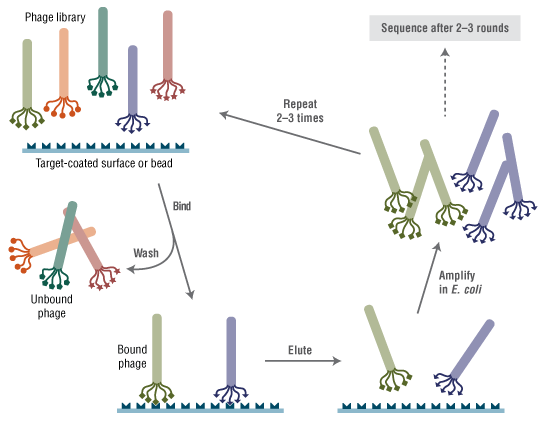上海金畔生物科技有限公司代理New England Biolabs(NEB)酶试剂全线产品,欢迎访问官网了解更多产品信息和订购。
产品信息
Ph.D.-7 噬菌体展示肽库的制备原理是将随机七肽组合库融合表达于 M13 噬菌体次要外壳蛋白(pIII)的 N 端(1–6)。展示的肽(7-mer)在 pIII 的 N 端表达,即成熟蛋白的第一残基属于第一个随机位点。这种肽后依次跟有短间隔序列(Gly-Gly-Gly-Ser)和野生型 pIII 序列。该库包含约 10 亿个电穿孔序列,在提供的 10 µl 噬菌体中经扩增一次,每个序列即可产生约 100 个拷贝。
噬菌体展示文献引用

对 pIII 上展示的五价肽库进行淘选。
- 产品类别:
- Discontinued (<3 years)
-
相关产品
相关产品
- Ph.D.™ 多肽展示克隆系统
-
参考文献
- Sidhu, S.S. et al. (2003). Chembiochem. 4, 14-25.
- Ferrer, M. et al. (1999). J. Pept. Res.. 54, 32-42.
- BouHamdan, M. et al. (1998). J. Biol. Chem.. 273, 8009-8016.
- Whaley, S.R. et al. (2000). Nature. 405, 665-668.
- Rozinov, M.N. and Nolan, G.P. (1998). Chem. Biol.. 5, 713-728.
- Rodi, D.J. et al. (1999). J. Mol. Biol.. 285, 197-203.
- Kraft, S. et al. (1999). J. Biol. Chem.. 274, 1979-1985.
- Koolpe, M. et al. (2002). J. Biol. Chem.. 277, 46974-46979.
- Mummert, M.E. et al. (2000). J. Exp. Med.. 195, 769-779.
- Hetian, L. et al. (2002). J. Biol. Chem.. 277, 43137-43142.
- White, S.J. et al. (2001). Hypertension. 37, 449-455.
- Azzazy, H.M. and Highsmith, W.E. (2002). Clin. Biochem. 35, 425-445.
- Binetruy-Tournaire, R. et al. (2000). EMBO J.. 19, 1525-1533.
- Kragler, F. et al. (2000). EMBO J.. 19, 2856-2868.
- Gazouli, M. et al. (2002). J. Pharmacol. Exp. Ther.. 303, 627-632.
- Romanczuk, H. et al. (1999). Hum. Gene Ther.. 10, 2615-2626.
- Nicklin, S.A. et al. (2000). Circulation. 102, 231-237.
- Jost, P.J. et al. (2001). FEBS Lett.. 489, 263-269.
- Rasmussen, U.B. et al. (2002). Cancer Gene Ther.. 9, 606-612.
- Tinoco, L.W. et al. (2002). J. Biol. Chem.. 277, 36351-36356.
- Stratmann, J. et al. (2002). J. Clin. Microbiol.. 40, 4244-4250.
- Mourez, M. et al. (2001). Nat. Biotechnol.. 19, 958-961.
- Rodi, D.J. et al. (2002). Curr. Opin. Chem. Biol.. 6, 92-96.
- Lee, L. et al. (2002). Arthritis Rheum.. 46, 2109-2120.
- Duerr, D.M. et al. (2004). J. Virol. Methods. 116, 177-180.
- Parmley, S.F. and Smith, G.P. (1988). Gene. 73, 305-318.
- Berggard, T. et al. (2002). J. Biol. Chem.. 277, 41954-41959.
- Chaudhary, J. et al. (2001). Am. J. Physiol. Cell Physiol.. 280, C1027-1030.
- Chen, L. and Sigler, P.B. (1999). Cell. 99,
- Biorn, A.C. et al. (2004). Biochemistry. 43, 1928-1938.
- Ferrer, M. and Harrison, S.C. (1999). J. Virol.. 73, 5795-5802.
操作说明、说明书 & 用法
-
操作说明
- M13 Titer Protocol for Ph.D. Phage Display
- M13 Amplifcation Protocol for Ph.D. Phage Display
-
说明书
产品说明书包含产品使用的详细信息、产品配方和质控分析。- manualE8100_E8101_E8110_E8111_E8120
FAQs & 问题解决指南
-
FAQs
- Which of the three ready-made libraries should I choose?
- Can a different bacterial strain be used with the Ph.D.™ Phage Display?
- No plaques are visible when titering using the Ph.D.™ Phage Display kit.
- I am using Ph.D.™ Phage display and the amplified phage titer is low.
- I am using Ph.D.™ Phage Display and the sequencing templates do not run where they should on a gel.
- I am using Ph.D.™ Phage Display and the phage DNA templates do not yield a readable sequence.
- When performing an experiment using Ph.D.™ Phage Display, the ELISA indicates that background binding to the plate is as high as binding to the target.
- When using the Ph.D.™ Phage Display, panning yielded a consensus sequence, but no ELISA signal.
- I am using Ph.D.™ Phage Display and the streptavidin control experiment did not yield the HPQ consensus sequence.
- Where can I find references for Ph.D.™ phage display libraries?
-
问题解决指南
- Phage Display Troubleshooting Guide
